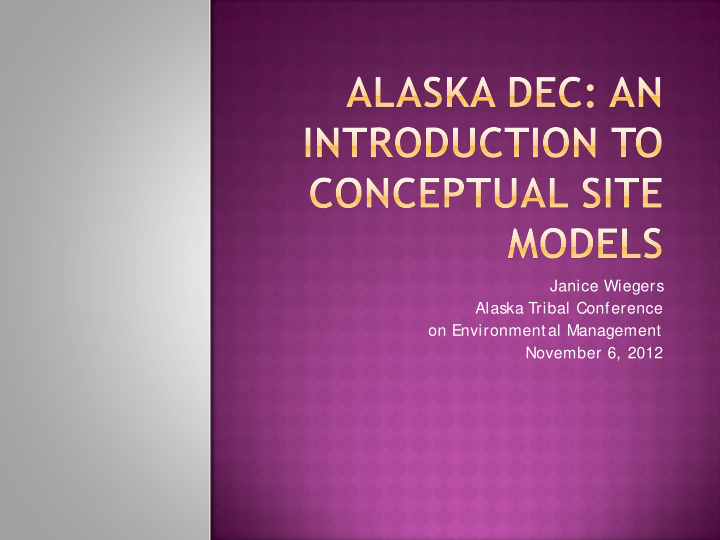



Janice Wiegers Alaska Tribal Conference on Environmental Management November 6, 2012
What is a Conceptual S ite Model Definitions: Complete Exposure Pathways Contaminant S ources Release Mechanisms Impacted Media Transport Mechanisms Exposure Media Exposure Routes Receptors Using the CS M S coping Form to Complete a CS M for a site
A conceptual site model (CS M) is a way to describe and evaluate how people, animals, and plants might come in contact with contaminants at a location. It shows the current and possible future spread of contaminat ion in the environment (i.e. fate and transport). Developing a CS M is a critical step in evaluating a contaminat ed site, and must be prepared during the site characterization phase.
Conceptual S ite Models identify exposure pathways and outline the course a chemical takes from the source of contamination to a potentially exposed person, animal or plant (receptor).
Generalized Example Exposure Pathways SOURCE IMPACTED Release Mechanism MEDIA (spill, leak, emission) EXPOSURE MEDIA RECEPTOR
All sources of contaminat ion at the site need to be identified. Many times the source is from a tank, drum, transformer, garage, shop, storage area, or landfill. Other sources may include discarded batteries, deteriorating buildings, or pesticide application.
S torage tanks: diesel, gasoline, and aviation fuel Power plants: transformer oil, PCBs, and waste oil Vehicle maintenance shops: waste oil, glycol, and chlorinated solvents Mining activities: fuels and heavy metals Former military activities: various contaminants Abandoned dumps: various contaminants S ome contaminants are more hazardous than others due to their different toxicities.
The release mechanism describes how contaminants were released from the source into the environment. Common release mechanisms include spills, leaks, direct discharge, and burning, etc. In some instances the release mechanism is unknown and may need to be an educated guess based on the available information.
The impacted media at a site are the environmental substances to which a contaminant is directly released. The impacted media may include soil, sediment, groundwater, surface water, or air.
Transport mechanisms show how contaminant s in the impacted environmental media may be moved to other media.
Exposure media is the environmental substance an individual is exposed to. Exposure media may include soil, sediment, groundwater, surface water, air, and biota (plants and animals). Exposure media includes all impacted media that people may directly have contact with.
An exposure route is the way a contaminant comes in contact with a receptor and the way a chemical enters the body. Ingestion Inhalation Dermal contact
Eating/ drinking (ingestion), Breathing (inhalation), and S kin (dermal) contact.
When determining human receptors for a site, it is important to keep in mind both current and future land use. This information should be included in the human health CS M. Potential receptors may include the following: Resident (adult and child); Commercial or industrial worker; Construction worker; S ite visitor; Trespasser; Recreational user; Farmer; S ubsistence harvester, or S ubsistence consumer.
Former tanks Public Drinking Water Well
Public Drinking Water Well S torage tanks Abandoned Generator Building
Community Drinking Depth = 2 feet bgs DRO = 37,700 mg/kg Water Well RRO = 33,300 mg/ kg Benzene = 0.192 mg/ kg Depth = 3 feet bgs DRO = 2,050 mg/kg Depth = 6 feet bgs DRO = 18,900 mg/kg GRO = 485 mg/ kg
Cross-section of the Hughes tank farm area drinking water well 37,700 mg/ kg 6’ 2,050 mg/ kg 18,900 mg/ kg Pot ent ial exposure rout es: indoor and out door inhalat ion, ingest ion soil and groundwat er, and dermal cont act . Primary groundwater flow direction
Complete Pathways Incomplete Pathways Incidental soil S urface water ingestion ingestion S kin contact with Wildfoods ingestion soil Outdoor or indoor inhalation Groundwater ingestion
Alaska Dept. of Environmental Conservation Janice Wiegers, Contaminated Sites Program
Recommend
More recommend